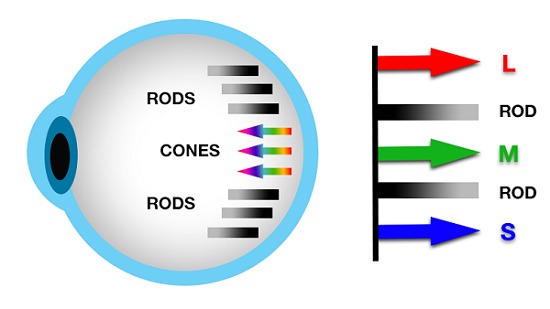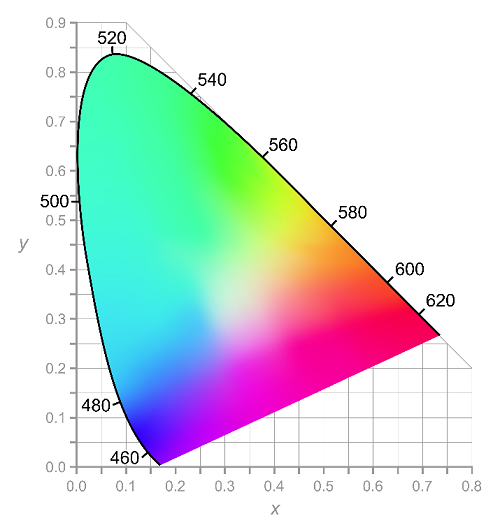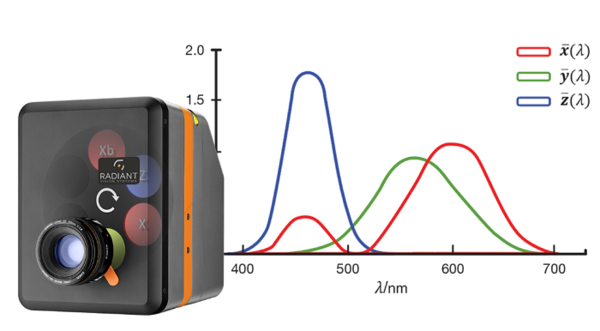Using Human Visual Perception to Guide Light & Color Measurement
The human eye contains photoreceptor cells that respond to light (electromagnetic waves), capturing it and converting it into signals that our brain interprets as images of the world around us. There are two main types of photoreceptors: rods and condes. Rods enable us to see at low light levels (scotopic vision) but do not provide color vision or spatial acuity. Cones provide vision at higher light levels (photopic vision), as well as color perception and spatial acuity.
There are three types of cones, each sensitive to different, yet overlapping, wavelengths of light. The entire spectrum of light visible to humans falls between approximately 380 nanometers (nm) and 750 nm. Each cone in the human eye responds to a part of this wavelength range (typically, the cones are associated with red, blue, and green wavelength ranges and are denoted S, M, and L for short, medium, and long wavelengths).

The cones in our eyes are responsible for our color perception. “S” cones generally respond to shorter wavelengths (for instance, blue), “M” cones respond to medium wavelengths (green), and “L” cones respond to long wavelengths (red).

The top bar shows the full spectrum of electromagnetic radiation, including invisible wavelengths such as X-rays, microwaves, and radio waves, plotted in order of increasing wavelength. The bottom bar is an expanded view of the visible light spectrum: the narrow range of the electromagnetic spectrum that the human eye can perceive.
Photometry is the science of measuring light as it is perceived by the human eye, and colorimetry applies the same principles to measuring the different wavelengths of light based on how we perceive color. (By comparison, radiometry is the science of measuring all wavelengths of light, including those beyond the human visual range.) In 1931 the Commission Internationale de L’éclairage (CIE) defined a standard for scientifically quantifying the physical properties of colors, enabling accurate representation and reproduction of those colors. A color gamut is the set of all colors available (producible) on a display device (a subset of the entire CIE color space).1

A graphical representation of the CIE 1931 color space, showing all colors visible to the human eye. The black numbers give the visible spectrum in wavelengths, while perceived colors are represented as coordinate points (x and y) within these limits.
Light and Color Metrology
Light measurement systems such as imaging photometers and colorimeters use CIE-matched optical filters and scientific-grade image sensors to apply these methods, capturing meaningful data that guide human-centric design and evaluation of many of today’s devices. Using photometric technology, manufacturers can leverage the standard principles of light and color measurement in design and production to best assess the visual quality of displays, backlit components, and light sources — as they are actually seen and experienced by users. This provides manufacturers with the means to achieve objective product quality.

A Radiant ProMetric® Imaging Colorimeter with integrated tristimulus color filter wheel (left). These filters enable the system to measure light according to the standard CIE color-matching functions representing human visual response to visible wavelengths (right).
At Radiant Vision Systems, we’ve been measuring light and color using these scientific principles for more than 25 years. We’ve worked with leading companies in the lighting, consumer electronics, display, automotive, aerospace industries and beyond to measure light sources such as LEDs and automotive headlamps; displays from smartphones and televisions screens to head-up displays (HUDs) and AR/VR headsets; and even non-illuminating surfaces (such as glass and metal) using subtle variations of light to enable defect detection.
Whether you’re a beginner to light and color measurement or a seasoned professional, Radiant offers a number of resources to review the basic guiding principles of human-centric measurement. You can learn more about measuring and quantifying human vision, the Language of Light, applications of photometry and colorimetry, and how we address the challenges of measuring unique new technologies such as AR/VR display devices and microLEDs, in our recent webinar: “Principles and Applications of Light and Color Measurement.” Presented in conjunction with Photonics Media, this webinar introduces the fundamental science and applications of light and color measurement. Presenter Jessy Hosken, Product Engineer at Radiant, provides a basic overview of photometry and colorimetry, and introduces photometric technologies that leverage these principles to accurately quantify the human visual response to guide quality in light and display products. Topics include:
- How the human eye responds to light and color
- Quantifying color based on CIE tristimulus curves
- Technology designed to replicate human visual response
- Optical metrology systems and benefits of imaging for light source and display measurement
The webinar is available to watch on demand with free registration through Photonics Media.

CITATIONS:
1. Carter, E., Schanda, J., Hirschler, R., Jost, S., Luo, M., Melgosa, M., … Wold, J. (2018). CIE 015:2018 Colorimetry, 4th Edition. doi: 10.25039/tr.015.2018
Join Mailing List
Stay up to date on our latest products, blog content, and events.
Join our Mailing List
